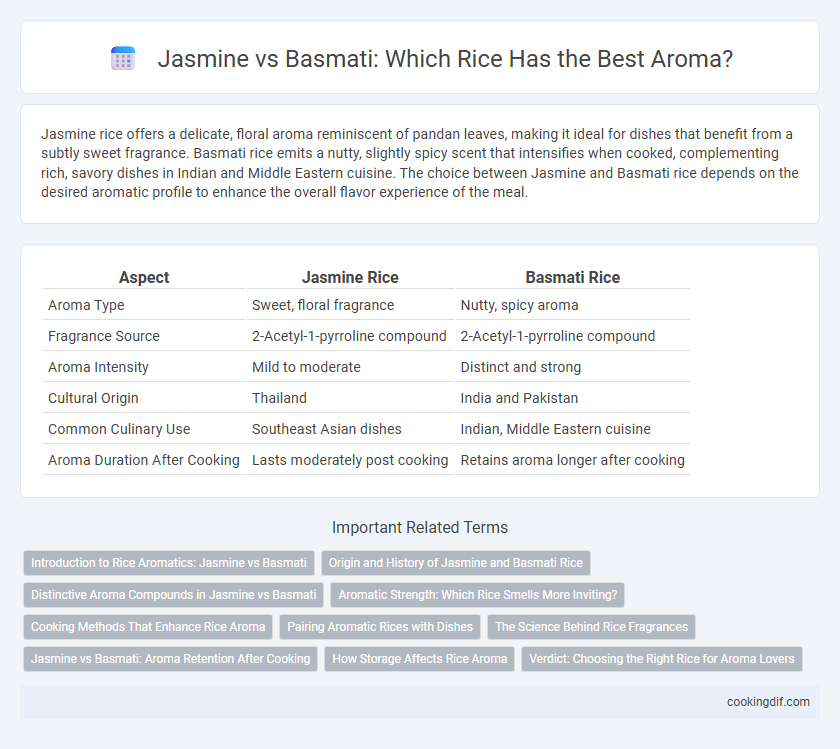Jasmine rice offers a delicate, floral aroma reminiscent of pandan leaves, making it ideal for dishes that benefit from a subtly sweet fragrance. Basmati rice emits a nutty, slightly spicy scent that intensifies when cooked, complementing rich, savory dishes in Indian and Middle Eastern cuisine. The choice between Jasmine and Basmati rice depends on the desired aromatic profile to enhance the overall flavor experience of the meal.
Table of Comparison
| Aspect | Jasmine Rice | Basmati Rice |
|---|---|---|
| Aroma Type | Sweet, floral fragrance | Nutty, spicy aroma |
| Fragrance Source | 2-Acetyl-1-pyrroline compound | 2-Acetyl-1-pyrroline compound |
| Aroma Intensity | Mild to moderate | Distinct and strong |
| Cultural Origin | Thailand | India and Pakistan |
| Common Culinary Use | Southeast Asian dishes | Indian, Middle Eastern cuisine |
| Aroma Duration After Cooking | Lasts moderately post cooking | Retains aroma longer after cooking |
Introduction to Rice Aromatics: Jasmine vs Basmati
Jasmine and Basmati rice are renowned for their distinct aromatic profiles, influencing culinary applications worldwide. Jasmine rice, originating from Thailand, releases a sweet, floral scent with subtle pandan-like notes when cooked, enhancing Southeast Asian dishes. Basmati rice, primarily cultivated in India and Pakistan, exudes a nutty, spicy aroma due to its unique aging process, making it ideal for biryanis and pilafs.
Origin and History of Jasmine and Basmati Rice
Jasmine rice originates from Thailand, where it has been cultivated for centuries, prized for its naturally fragrant aroma reminiscent of pandan and popcorn. Basmati rice, native to the Indian subcontinent, particularly the Himalayan foothills of India and Pakistan, is renowned for its distinct nutty fragrance and elongated grains that have been a staple in South Asian cuisine for over 4,000 years. The unique aroma of both rice varieties is a result of the compound 2-acetyl-1-pyrroline, naturally occurring in their respective origins, contributing to their celebrated sensory qualities in global markets.
Distinctive Aroma Compounds in Jasmine vs Basmati
Jasmine rice is characterized by its distinctive aroma primarily due to the presence of 2-acetyl-1-pyrroline, which imparts a sweet, popcorn-like fragrance. Basmati rice also contains 2-acetyl-1-pyrroline but in higher concentrations, giving it a more intense and nutty aroma. The varying levels and additional volatile compounds, such as aldehydes and alcohols, contribute to the unique scent profiles of Jasmine and Basmati rice.
Aromatic Strength: Which Rice Smells More Inviting?
Jasmine rice is renowned for its strong, sweet floral aroma, often compared to pandan leaves, providing a distinctly inviting scent that enhances Southeast Asian dishes. Basmati rice emits a nutty, spicy fragrance with hints of popcorn, offering a subtler yet rich aroma highly prized in Indian and Middle Eastern cuisine. Between the two, Jasmine rice generally exhibits a more potent aromatic strength, making it the preferred choice for those seeking a vivid and immediate scent experience.
Cooking Methods That Enhance Rice Aroma
Steaming jasmine rice preserves its natural floral aroma by using minimal water and gentle heat that intensifies its fragrance during cooking. Basmati rice develops its characteristic nutty and spicy aroma when soaked prior to cooking and simmered with a precise water-to-rice ratio, allowing the grains to fluff properly without excess moisture. Using aromatic cooking methods like adding whole spices or cooking in a sealed pot enhances the olfactory experience unique to each variety.
Pairing Aromatic Rices with Dishes
Jasmine rice features a delicate, floral aroma that enhances Southeast Asian dishes like Thai curries and stir-fries, complementing their vibrant flavors without overpowering them. Basmati rice offers a nutty, fragrant scent ideal for Indian and Middle Eastern dishes, pairing well with spiced biryanis and grilled meats by absorbing bold seasonings. Selecting the right aromatic rice elevates the dining experience by harmonizing the grain's scent with the dish's seasoning profile.
The Science Behind Rice Fragrances
Jasmine and Basmati rice aromas are distinguished by distinct volatile compounds that trigger unique sensory experiences; Jasmine rice contains higher levels of 2-acetyl-1-pyrroline, which imparts a floral, popcorn-like fragrance. Basmati rice's aroma is characterized by a combination of 2-acetyl-1-pyrroline and other aromatic compounds such as hexanal and aldehydes, giving it a spicy, nutty scent. These aromatic molecules are produced during grain maturation and vary due to genetic differences and environmental factors affecting aroma intensity and profile.
Jasmine vs Basmati: Aroma Retention After Cooking
Jasmine rice is known for its naturally sweet, floral aroma that intensifies during cooking but tends to dissipate quickly once cooled, while Basmati rice offers a distinct nutty fragrance that retains its scent longer after cooking. The key compound in Jasmine rice responsible for its aroma is 2-acetyl-1-pyrroline (2AP), which is more volatile and evaporates faster compared to Basmati's aromatic profile. Basmati rice's lower moisture content and grain structure help preserve its aromatic qualities for extended periods, making it ideal for dishes where aroma retention is crucial.
How Storage Affects Rice Aroma
Jasmine rice retains its floral, pandan-like aroma best when stored in an airtight container away from moisture and heat, as exposure to air diminishes its fragrant oils rapidly. Basmati rice's distinctive nutty and popcorn-like scent is more resilient but still weakens over time if stored improperly, especially in high humidity or fluctuating temperatures. Proper storage in a cool, dry environment preserves the volatile compounds responsible for the characteristic aromas of both jasmine and basmati rice.
Verdict: Choosing the Right Rice for Aroma Lovers
Jasmine rice offers a naturally sweet and floral aroma that intensifies when cooked, making it ideal for dishes requiring a fragrant, delicate scent. Basmati rice presents a nutty, slightly spicy aroma known for complementing Indian and Middle Eastern cuisine with a more distinct, pungent fragrance. Aroma lovers seeking a subtly sweet, fragrant experience prefer Jasmine, while those who enjoy a bold, aromatic punch often choose Basmati.
Jasmine vs Basmati for rice aroma Infographic

 cookingdif.com
cookingdif.com